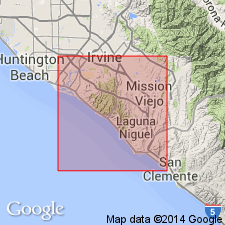
- Usage in publication:
-
- Los Trancos member*
- Modifications:
-
- Named
- Biostratigraphic dating
- Dominant lithology:
-
- Siltstone
- Sandstone
- AAPG geologic province:
-
- Transverse Ranges province
Summary:
Named as middle member (of 3) of Topanga formation for Los Trancos Canyon that originates in San Joaquin Hills and empties into sea at Crystal Cove. Typical exposures occur in area between Los Trancos Canyon and Bonita Creek in western part of San Joaquin Hills [Laguna Beach and Tustin 7.5'quads, Orange Co, CA]. Consists mainly of dark-gray siltstone interbedded with light-gray medium-grained sandstone that is locally tuffaceous. Is about 3100 ft thick. Conformably overlies Bommer member (new); apparently disconformably underlies Paularino member (new) (both of Topanga formation). Foraminifers found at several localities in member are regarded as Kleinpell's Relizian Stage (middle Miocene age).
Source: GNU records (USGS DDS-6; Menlo GNULEX).
For more information, please contact Nancy Stamm, Geologic Names Committee Secretary.
Asterisk (*) indicates published by U.S. Geological Survey authors.
"No current usage" (†) implies that a name has been abandoned or has fallen into disuse. Former usage and, if known, replacement name given in parentheses ( ).
Slash (/) indicates name conflicts with nomenclatural guidelines (CSN, 1933; ACSN, 1961, 1970; NACSN, 1983, 2005, 2021). May be explained within brackets ([ ]).

